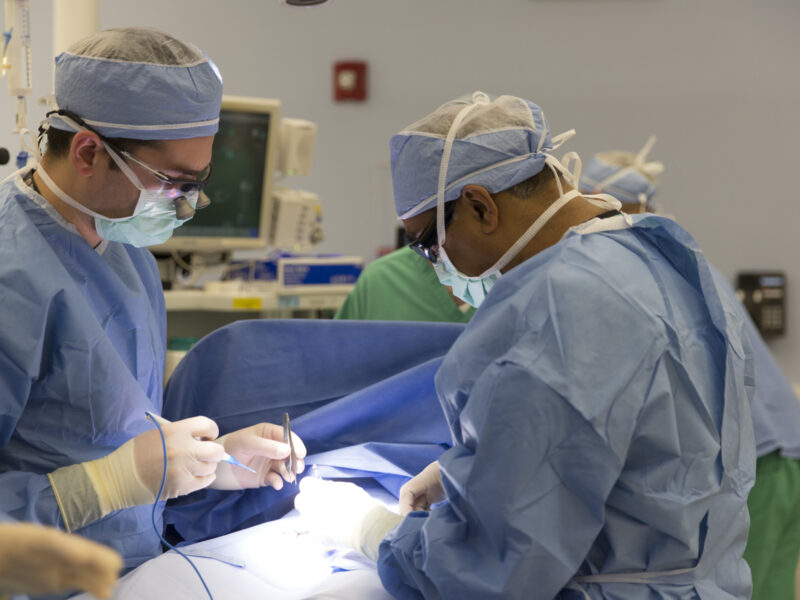Intraoperative Evaluation of Penile Blood Flow During Bladder Exstrophy
Intraoperative Evaluation of Penile Blood Flow During Bladder Exstrophy https://pediatricsnationwide.org/wp-content/themes/corpus/images/empty/thumbnail.jpg 150 150 Mary Bates, PhD Mary Bates, PhD https://secure.gravatar.com/avatar/c6233ca2b7754ab7c4c820e14eb518c8?s=96&d=mm&r=g- April 13, 2023
- Mary Bates, PhD
Laser angiography technology allows for real-time measurements of penile perfusion during exstrophy repair operations.
In a new pilot study, researchers from the Pediatric Urology Midwest Alliance (PUMA) demonstrated that intraoperative laser angiography is a safe and easy method to evaluate penile perfusion during bladder exstrophy closure.
The optimal technique for repair of bladder exstrophy in boys is strongly debated. Some physicians favor complete repair of the bladder and urethra at the same time, while others prefer doing an initial repair of the bladder and repairing the urethra at a later time. Although infrequent, there are reports of serious injury to the penis occurring during the complete repair procedure.
“There have not been any objective studies done to assess penile blood flow during surgery,” says Rama Jayanthi, MD, chief of the Department of Pediatric Urology at Nationwide Children’s and senior author of the study. “The idea behind using intraoperative laser angiography was to have real-time evaluation of the overall health of the penis during the exstrophy closure itself.”
In their analyses, Dr. Jayanthi and colleagues included eight consecutive patients undergoing bladder exstrophy repair. The patients were evaluated at four stages of their operation using a laser angiography system, which consist of the infusion of indocyanine green to measure blood flow. This technique has been used in numerous other specialties to evaluate tissue viability and guide surgical approach.
Using SPY technology, the researchers found that a significant reduction in penile blood flow may occur during the course of the operation, often without any outward clinical signs. Internal rotation of the hips resulted in an average 50% reduction in penile perfusion, and this decrease in blood flow was further accentuated in those patients who underwent a complete repair operation.
However, none of the patients showed signs of penile injury or tissue loss at three months follow-up. The researchers say that the threshold at which decrease in penile perfusion may result in injury is currently not known.
The researchers hope that with additional data, they may be able to identify which patient characteristics and which thresholds for penile perfusion are associated with patient outcomes. For now, they say the technology still has an important role in driving decisions intraoperatively.
“Now that we have a measurement for blood flow to the penis during this operation, we can use this moving forward to make informed decisions about how to repair these patients,” says Martin Kaefer, MD, a pediatric urologist at Riley Hospital for Children and lead author of the study. “If you see that blood flow is significantly dropping during the operation, you could modify your approach intraoperatively based on these real-time measurements.”
“We at the PUMA consortium are using this technology during exstrophy closures to help guide our decision-making,” says Dr. Jayanthi, who is also a clinical professor of urology at The Ohio State University College of Medicine.
“We hope that other centers also consider using it as they close exstrophies so we can all better understand the utility of this technology.”
Reference:
Kaefer M, Saad K, Gargollo P, Whittam B, Rink R, Fuchs M, Bowen D, Reddy P, Cheng E, Jayanthi R; Pediatric Urology Midwest Alliance (PUMA). Intraoperative laser angiography in bladder exstrophy closure: A simple technique to monitor penile perfusion. Journal of Pediatric Urology. 2022 Dec;18(6):746.e1-746.e7. doi: 10.1016/j.jpurol.2022.10.012. Epub 2022 Oct 14.
About the author
Mary a freelance science writer and blogger based in Boston. Her favorite topics include biology, psychology, neuroscience, ecology, and animal behavior. She has a BA in Biology-Psychology with a minor in English from Skidmore College in Saratoga Springs, NY, and a PhD from Brown University, where she researched bat echolocation and bullfrog chorusing.
-
Mary Bates, PhDhttps://pediatricsnationwide.org/author/mary-bates-phd/December 27, 2016
-
Mary Bates, PhDhttps://pediatricsnationwide.org/author/mary-bates-phd/
-
Mary Bates, PhDhttps://pediatricsnationwide.org/author/mary-bates-phd/
-
Mary Bates, PhDhttps://pediatricsnationwide.org/author/mary-bates-phd/
- Post Tags:
- bladder exstrophy
- Surgery
- Urology
- Posted In:
- Clinical Updates
- In Brief
- Research






